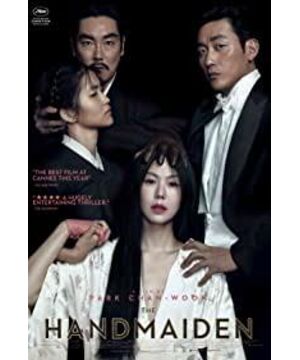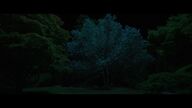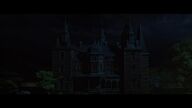The day before yesterday, a topic was caused by someone plagiarizing Stephen King. I wrote a paragraph on Weibo, saying that the editor couldn't see anything unusual about Stephen King, and the editor couldn't see Bai Xianyong, a teenage girl It's not unusual to be able to write words like "Niezi". Text is a very delicate thing, the core is different, and changing the shell can't hide the true colors. Culture has its original context, just like the idea of suspect X does not appear in the minds of Chinese people, culture has obvious regionality, which is obvious at a glance.
Just like the Korean movie "Miss", it looks like a freak at first glance. No matter how much you move flowers and trees, you can't change the British tone diffused in the story. Even if you move to the Japanese occupation era, you can't dispel the soot and fog in London. The bright garden mansion is still full of thorns and vines. He came out of the fog, revealing his mouth full of charred teeth, and his fingernails filled with soot.
Originally, after the Meiji Restoration, the upper class in Japan had all learned from Western Europe and learned half-heartedly. The men wore gray morning dresses with striped trousers, and the women wore lace dresses with a plate head. The restrained posture could not support the straight suit with the ponytail, and the stance with the chest and the hunched shoulders did not show the style of the Edwardian period. South Korea was colonized by Japan for 50 years. I learned from the West with a half-assed teacher, and even learned a little bit. "Miss" moved the film background from the Victorian era to the Japanese occupation period, but Dickens was still telling the story of an Oliver Twist. Content and appearance are really inconsistent.
This story is "Oliver Twist" + "Desolate Villa" + "A Tale of Two Cities" + "Woman in White", it is realism + gothic style + romanticism, it is an ancient mansion in the countryside, it is the thick fog that does not disperse at noon, yes The bleak afternoon sun, the rainy days, the library to the ceiling, the book ink and paper, the dark manor of old oaks, the towers with ivy and rose branches, the dirty sewers of London The smell, the stench of the ghetto air, the cold rooms of the madhouse, the moldy black bread of the workhouse, the dim light of the debtor's prison, the more familiar you are with Dickens, the more familiar you are with The Lady. In a world without workhouses, madhouses, nurseries, Rand Street, and Thorns, this story cannot hold.
The place where Nan Shuji lives is the nursery's home on Rand Street, the pickpocket's den of "Oliver Twist", and the thief street of Oliver Twist; the place where Xiuzi lives is "Bleak Villa"; The plot of the lunatic asylum, from Collins' "The Woman in White." From "Miss" back to "Fingersmith Love Picking", Maud's complete explosion when he scratched the original book is a fire of the mad woman in "Jane Eyre"; Maud and Su's handling of property is Jane Eyre Divide Uncle's estate among St. John and two cousins; Maud kills his lover, a copy of Bill killing Nancy; Aunt Saxby takes the blame for her daughter, A Tale of Two Cities.
Watching "Fingersmith Love Picking", although the plot has been flipped again and again, every plot can find its origin, and readers who are familiar with Dickens can even guess the ending. Dickens' stories are full of intrigue and calculation, wealth and inheritance, inheritance and gift, wedlock and illegitimate life, marriage and elopement, reality and past, lawyers and creditors, legal documents and suicide notes, criminals and witnesses, necklace lockers and Wedding rings, workhouses and orphanages, washerwomen and drunkards, lung disease and drowning, gallows and dead men. In the era in which Hideko lived in the movie "Miss", the law of inheritance alone could make a lover's plan fail. Not to mention the layout of Big Mama Saxby.
Sarah Waters, the author of the original book Fingersmith, wrote her doctoral dissertation titled "lesbian and gay historical fictions, 1870 to the present" , I have collected so much information and just writing the thesis is too wasteful. After the thesis is written, the information becomes the details of the novel, and I wrote "Tipping the Velvet" and "Fingersmith". There are many British modern and contemporary writers who draw nutrients from Dickens. At the beginning of J.K. Rowling's "Harry Potter", the foot of the stairs where Harry lived and the dump alley that Hagrid took him to are all "The Fog". The shadow cast by Orphans.
Although the story background of "Fingersmith's Love" is extended from Dickens, the characters Su and Maud are the output of the author. It's especially wonderful that TV shows convert words into images. The dimness of the light in the film makes Maud as delicate as an angel and as white as a pearl. Wrapped in layers of conspiracy is a beautiful picture. It's hard to believe that Maud's background will give her such a fragile face, and Su's own bloodline should make her more beautiful. Su's not beautiful enough can be regarded as the only shortcoming of this film.
The theme of this story is betrayal and forgiveness. Love does not allow conspiracy secrets and betrayal, love must be tolerant and forgiving. Love is a luxury, not a necessity. Love is not something that everyone can and must have. Love does not even come from heredity and innate like appearance and wisdom. Love is just accident and fate. Among thousands of people, it is not so easy for two people to meet each other, from looking at each other and laughing, then being heartbroken, and then meeting their souls.
The story of Maud and Sue, written by Sarah Waters, was facilitated by Aunt Saxby. This is a female author's concern and love for the female group, giving them the most tragic fate, the most tangled process, and the most romantic ending, picking a Charlotte Bronte painting from the moldy London soil written by Dickens. Thornfield Pheasant upstairs yearns for the little flowers of freedom and equality, breathes the air of the cold conspiracy of the Collins madhouse, and finally blooms the romantic roses in women's hearts. The two girls are so heartbreaking, Maud's fragility and strength, madness and calmness, Su's innocence and vanity, kindness and recklessness, the fate of the two seventeen-year-old girls is not determined by them, one is in the eyes of others. Fat, a tool in the eyes of others, is easily used by others, and they don't spare their feelings and lives. In the end, they save themselves and their lovers by themselves. This is the idealism and goodwill of female authors for their characters.
This kindness can't be seen in "Miss", "Miss" is a male director's staring at and molesting female objects. Those explicit pornographic texts should not only be read out by women with sweat, but also made by them. Perform at full strength. In "Miss", you can't see their screams. The director's gaze through the lens turns into countless hands reaching out, just like the tentacles of octopuses in the pornographic pictures, entangling their bodies and strangling their throats. Top drowning. While they were sinking, they also had to show pleasure and demonstrate to him. Even the escape from the lunatic asylum, the hidden struggle against the shackles of male power, is vague, and the kind of indifference that disguise is too lazy to pretend is his true face.
"We met in the most turbulent and absurd of years, with nothing but love," Sarah Waters said.
View more about The Handmaiden reviews











